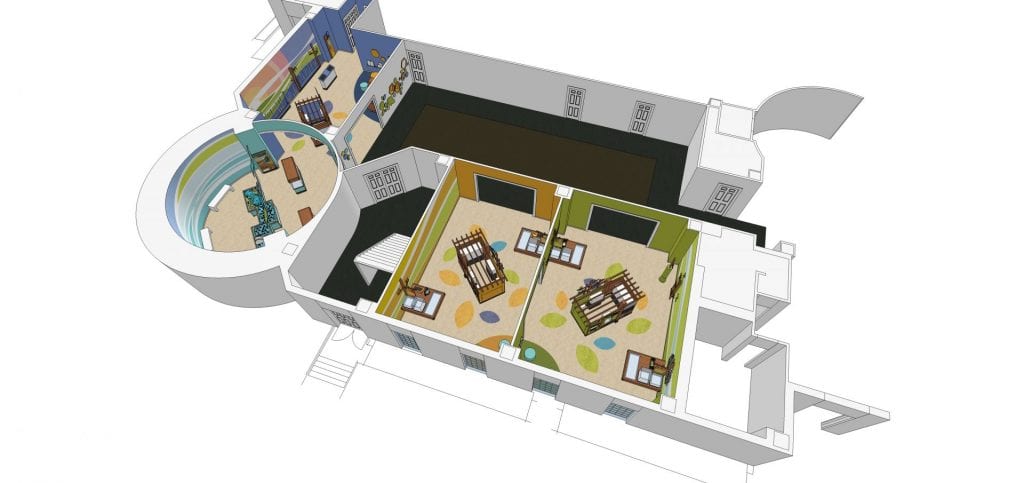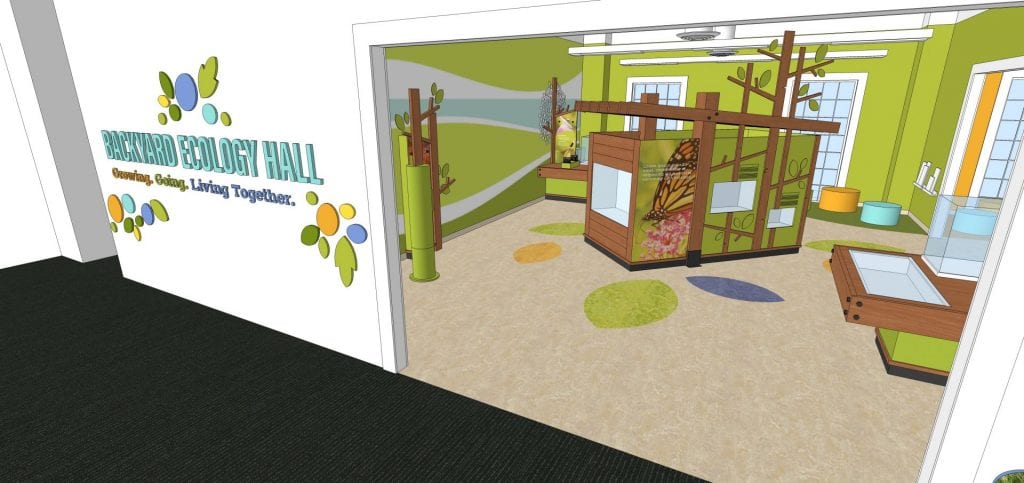By Courtney Doucet
A new long-term exhibit area called the Backyard Ecology Hall, highlighting ecosystems in the Waco area, will debut this fall in the Jeanes Discovery Center at Baylor University’s Mayborn Museum Complex. It’s designed to provide hands-on learning experiences for visitors through exhibits that have interactive walls, climbable honeycomb and microscopes, as well as make solid connections to current research being done at Baylor.
“Our target age group for the new Backyard Ecology Hall is fourth through sixth grades, which accomplishes the Mayborn’s goal of enhanced visitor experience, but it will also offer engaging content appropriate for learners of any ages,” said Trey Crumpton, the Mayborn Museum’s exhibits manager.
Space in the museum’s Jeanes Discovery Center is now being renovated at cost of $1.2 million to provide a home for the Backyard Ecology Hall and accommodate all of its features. Part of the renovation cost was raised from the success of the “Titanic: The Artifact Exhibition” special exhibit that the Mayborn hosted last fall. Some of the attractions previously located in the Ecology Hall space, such as the communications and TV news and weather exhibits, will be relocated within the museum.
The Ecology Hall is a collaboration between the Mayborn Museum and Roto, a design and production company based in Ohio. Roto is responsible for the design and installation of the exhibit area, which was created specifically for the Mayborn.
“One of the things that our staff, Roto and our outside consultants all said about this project is that what makes it really unique, and an asset to Baylor and Waco, is that it combines specimens from the Baylor research collection housed at the Mayborn and live animals and interactives,” Crumpton said. “Bringing those three things together is really going to make this special and unique because there are not many places where you find all of those in the same space. By combining them, this experience can provide the spark inherent in informal science education.”
Crumpton has been working closely with Roto to coordinate the Backyard Ecology Hall. In addition, the Mayborn Museum has enlisted the help of other resource providers to add their expertise to the exhibit.
“It’s definitely a collaborative process, not only with our staff and Roto, but with a community-wide advisory panel that consists of Baylor Arts & Sciences faculty, educators from around Waco and staff from the Cameron Park Zoo,” Crumpton said. “This project has benefited from an advisory panel of Baylor faculty in several departments relevant to the subject matter — biology, environmental science, geosciences, the Center for Reservoir and Aquatic Systems Research at Baylor and Baylor Sustainability, as well as from community expert educators and museum members.”
Four special spaces, each with a purpose
The new Backyard Ecology Hall updates four discovery rooms, each with its own theme that connects to the ecology found in our own backyards.
“This is going to provide more opportunities to engage. There will be a large number of people able to be involved with different activities in each room. We are really excited about that,” said Rebecca Tucker Nall, assistant director of communication for the Mayborn Museum.
The Amazing Abilities space will be an area that “celebrates the cool and weird things that nature –– and you –– can do.” It will show certain animals and what abilities they have, as well as how they live with other animals and within the context of the ecology of the Waco area. This space will feature a Monarch butterfly migration interactive, a “snake squeeze” interactive, a sketching station using real natural history specimens, and a “My Amazing Abilities” visitor response station.
The Forms with a Purpose space space will demonstrate and teach the ways that different species of animals adapt to their surroundings by way of survival mechanisms such as camouflage and other adaptive forms.
“The shapes, sizes, colors and patterns we see in nature all have a function in survival,” Crumpton said. The area will teach visitors how the forms that plants and animals adapt benefit them in their ecosystems. A camouflage challenge and video microscope interactive will be available for hands-on learning.
The Brazos River Gallery will showcase living things that can be found in the Brazos River, which passes just behind the Mayborn Museum. This area will also explore the constant motion of water due to forces of Earth. A playable, Brazos-themed water table will supplement this area and provide interactive examples.
“The physical world is always in motion –– changed by dynamic forces. This area will explore Earth’s power within the context of the familiar Brazos River,” Crumpton said. “The idea of the Brazos River Gallery is that you will feel immersed in the river. There will be two large aquatics tanks with live fish and turtles that inhabit and can be found in the Brazos. It will feel as if you are walking into the river.”
The final space, the Living Together room, will show how animals and plants live together in ecosystems and how humans also contribute to these systems.
“Forces of nature create complex connections and unique relationships. No plant or creature is totally isolated or self-sufficient, so we all share the challenge of reliance,” Crumpton said. “This area will focus on interconnections of animals and plants, and the human place in ecology.”
The room’s attractions will include an interactive wall that will explain the ways in which animals and insects pollinate plants, a honeycomb-shaped climbing structure and a Baylor Research Station focused on current projects.
Every room of the Backyard Ecology Hall will combine knowledge with interactive components and live animals. All of the information included in the exhibit comes from the Baylor and Waco community, providing knowledge that those who live in the area can connect with while enjoying interactives designed to promote learning.
“Support and input from our loyal constituents and friends helps us fulfill our mission to engage our community and inspire lifelong learning. We want this to be an active space,” Crumpton said, “We’ve selected animals from our living collection to put on exhibit to help connect the main concepts of backyard ecology to the animals visitors might see in their own ecological backyard such as box turtles, rattlesnakes and geckos.”
The Backyard Ecology Hall is slated to officially open in September 2019, and will be included in the price of museum admission. Baylor students will be able to access the exhibit for free with their student IDs. Membership passes to the Mayborn museum are available on the Mayborn Museum’s website at www.baylor.edu/mayborn.




